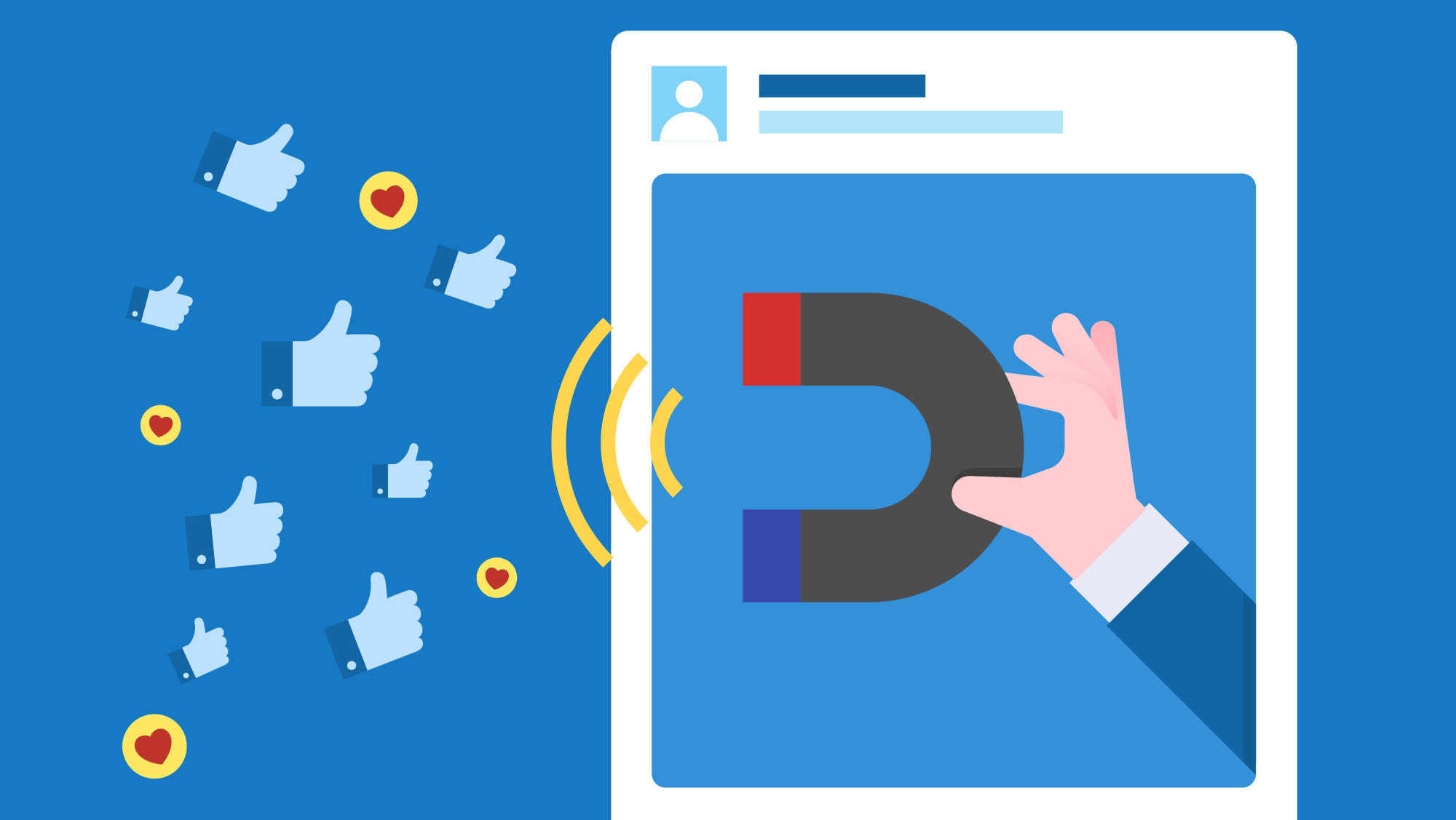
What are Meta Ads: A Beginner’s Guide
What are Meta Ads: A Beginner’s Guide
With more businesses shifting their eyes to digital channels, the landscape of online advertising is busier than ever. Amid this rapid change, Meta Ads stands out as a powerful tool, driving brand awareness, engagement, and sales across a massive global audience. But what exactly are Meta Ads, and why has this network taken centre stage in the digital marketing world?
Peeling back the layers starts with recognition: Meta, previously known as Facebook, isn’t simply a social network anymore. Under this umbrella, you’ll find Facebook, Instagram, Messenger, and Audience Network. Meta Ads are the platform’s collective engine for paid promotions, weaving brands directly into people’s scrolling, stories, and feeds.
What are Meta Ads?
Meta Ads are digital advertisements created and managed through Meta’s advertising platforms, including Facebook, Instagram, Messenger, and the Audience Network. They allow businesses and individuals to promote their products, services, or messages to highly specific audiences based on interests, demographics, and behaviours. With a range of ad formats—such as image, video, carousel, and story ads—Meta Ads provide flexible and powerful tools for reaching potential customers, building brand awareness, and driving measurable results across some of the world’s most popular social media channels.

How Meta Ads Work
At its core, Meta Ads takes your message and places it where your audience is spending their time. It operates through a self-serve ad platform that gives anyone — from small boutique firms to global powerhouses — the tools to create targeted, eye-catching, and interactive adverts.
It’s not just about displaying an image or short video. The system works by harnessing sophisticated data to predict which people are most likely to respond, and in which context your ads are most likely to drive action.
Ad campaigns begin in Meta Ads Manager, which functions as the command centre for everything, from building creatives to analysing campaign results. Marketers pick their goals, whether it’s more website visits, video views, or online purchases, and the system handles placement and bidding in real time across its suite of platforms.
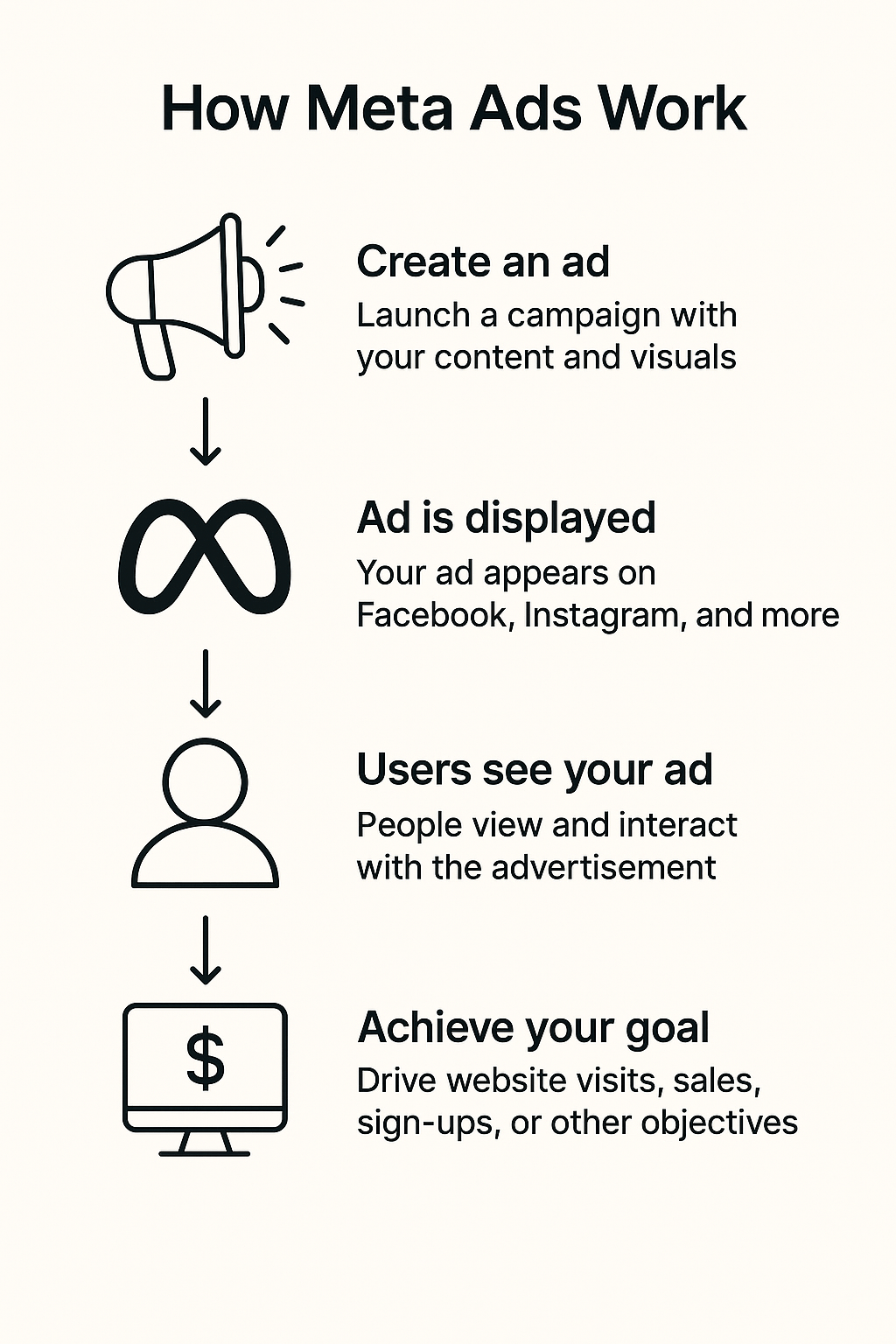
Where Your Ads Appear
Meta Ads reach across several key locations, including:
- Facebook News Feed and Stories
- Instagram Feed, Explore, and Stories
- Messenger
- Facebook Marketplace
- Audience Network (placing ads in third-party websites and apps)
This range means your ads can reach people at different times, from their morning scroll through Facebook, to a quick Instagram browse, or during a chat on Messenger.
Sample Placements Table
| Platform | Placement Types | Example Reach |
|---|---|---|
| News Feed, Marketplace, Stories | 2.9 billion users | |
| Feed, Stories, Reels, Explore | 2 billion users | |
| Messenger | Inbox, Sponsored Messages | 1.3 billion users |
| Audience Network | In-app, websites | Varies (global) |
These massive numbers combine to give businesses access to a broader audience than nearly any other advertising channel.
Types of Meta Ads
The versatility of Meta Ads rests in its variety. Whether you’re after video, a carousel showcasing several products, or immersive stories, options abound. Some popular ad formats include:
- Image Ads: Clean, direct, and visually striking. Ideal for promoting single products or events.
- Video Ads: Tell a story or demonstrate your product in action. Videos can be short and punchy or longer for those who want detail.
- Carousel Ads: Multiple images or videos within a single ad, each with its own link. Perfect for highlighting a range or telling a sequential story.
- Story Ads: Full-screen vertical ads on Facebook and Instagram Stories. Quick, intimate impressions designed for mobile.
- Collection Ads: Allow people to browse and purchase products directly from the ad.
- Lead Ads: Collect customer details without them needing to leave the platform.
The vast array of options means you can tailor your campaign to fit almost any goal and creative preference.
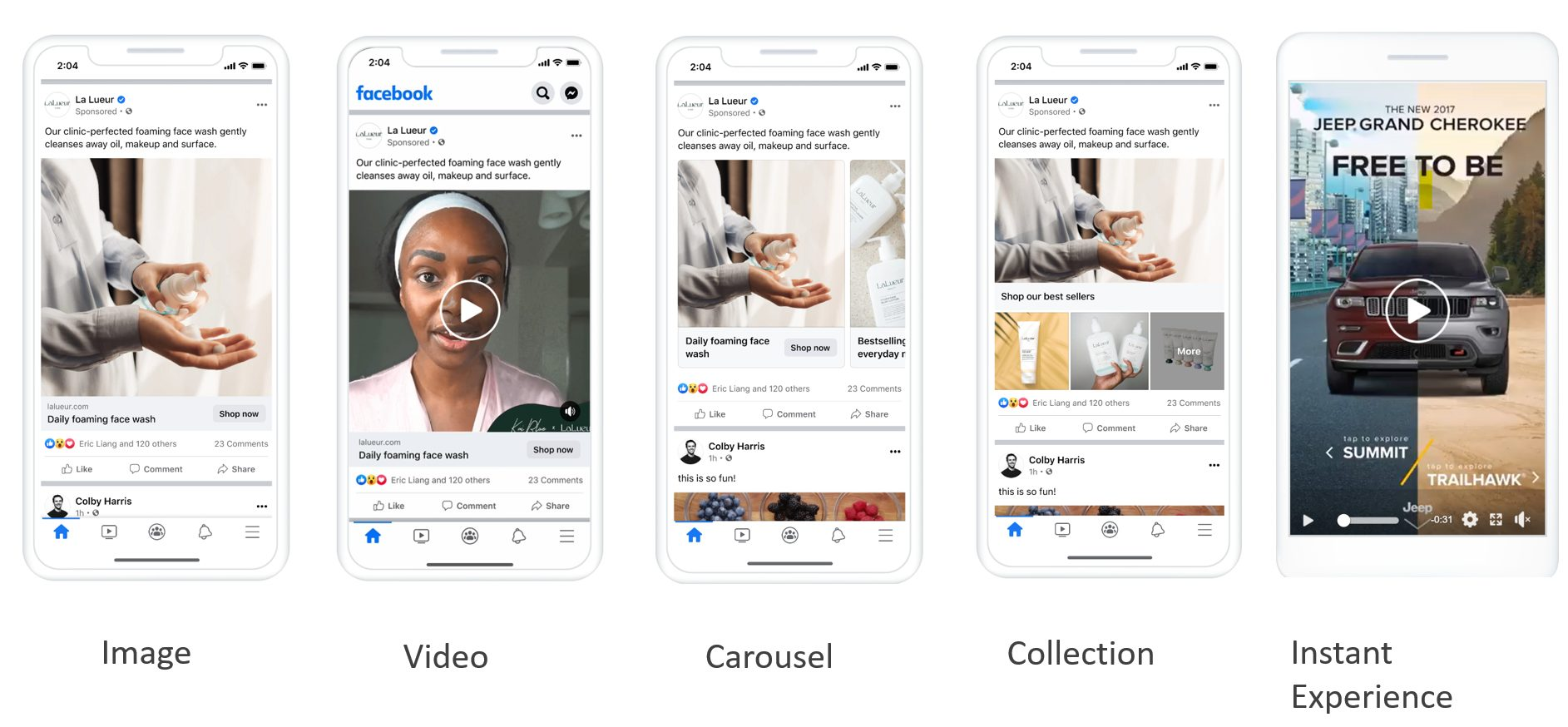
Image Source: 303
Targeting: Speaking to the Right People
One aspect that sets Meta Ads apart is their granular targeting capability. Rather than spending on a broad audience in hopes of catching the right people, advertisers can zero in based on:
- Demographics (age, gender, location)
- Interests (pages liked, interactions, hobbies)
- Behaviours (purchase history, device usage)
- Custom audiences (upload existing customer lists)
- Lookalike audiences (find new people similar to your existing customers)
With these tools, a clothing shop could target only women aged 25–45, interested in sustainable fashion, living within a specific radius of a city. Or a software startup could reach business owners, who have already visited their website, across both Instagram and Facebook.
Audience targeting becomes even smarter over time. As campaigns run, Meta’s machine learning refines who sees your ads, focusing more on what works.
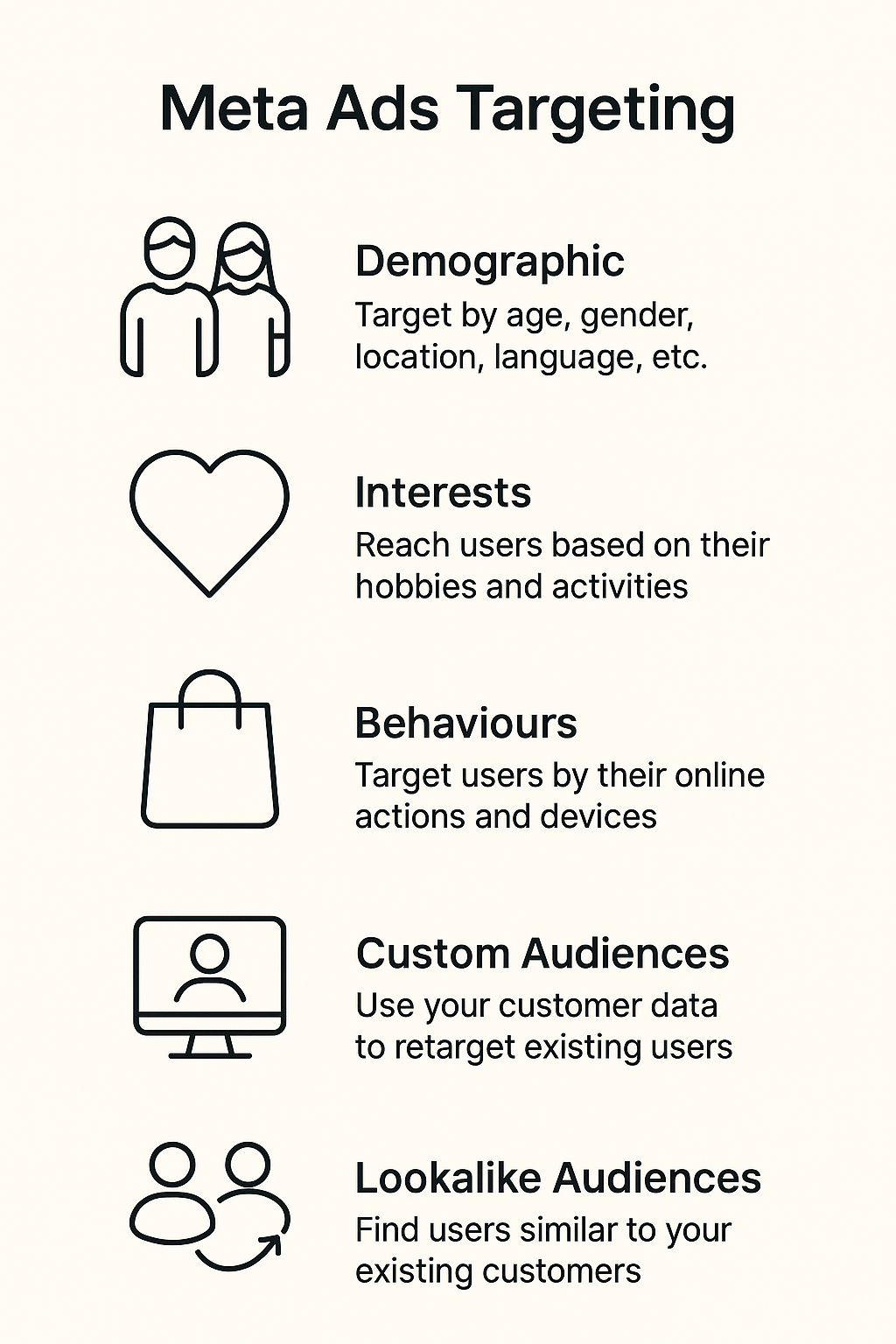
Choosing Campaign Objectives in Meta Ads
Selecting the right campaign objective is the foundation of a successful Meta Ads strategy. Meta offers a range of objectives designed to align with your business goals and guide your ad delivery towards the results you care about most. Here’s a breakdown of the main objectives, when to use them, and how to make the best choice for your campaign.
Meta Ads Campaign Objectives
1. Awareness
- Brand Awareness: Increase recognition of your brand among your target audience. Best for: New businesses, product launches, or when entering new markets.
- Reach: Show your ad to as many people as possible within your target audience. Best for: Maximising exposure, promoting events, or building local awareness.
2. Consideration
- Traffic: Drive users to your website, app, or event. Best for: Blog posts, landing pages, product pages, or app downloads.
- Engagement: Boost post interactions, Page likes, event responses, or offer claims. Best for: Building social proof, increasing page followers, or promoting special offers.
- App Installs: Encourage people to download and use your app. Best for: Mobile apps seeking rapid growth.
- Video Views: Promote videos to increase views and engagement. Best for: Brand storytelling, product demos, or testimonials.
- Lead Generation: Collect leads directly within Meta platforms using forms. Best for: Newsletter sign-ups, quote requests, or event registrations.
- Messages: Start conversations with potential customers via Messenger, WhatsApp, or Instagram Direct. Best for: Customer support, personalised offers, or direct sales.
3. Conversion
- Conversions: Drive valuable actions on your website, app, or Messenger, such as purchases or sign-ups. Best for: E-commerce, SaaS sign-ups, or booking services.
- Catalogue Sales: Show products from your catalogue to generate sales. Best for: Online retailers with multiple products.
- Store Traffic: Drive visits to your physical locations. Best for: Brick-and-mortar stores, restaurants, or local services.
How to Choose the Right Objective
- Define Your Goal: What is the single most important outcome you want from your campaign? (e.g., awareness, website visits, sales)
- Match to Objective: Select the Meta objective that aligns with your goal.
- Consider Your Audience: Some objectives work better for broad audiences (Awareness), while others are ideal for retargeting or high-intent users (Conversion).
- Test and Optimise: Start with your best-fit objective, but don’t hesitate to test alternatives as your strategy evolves.
Decision Flowchart
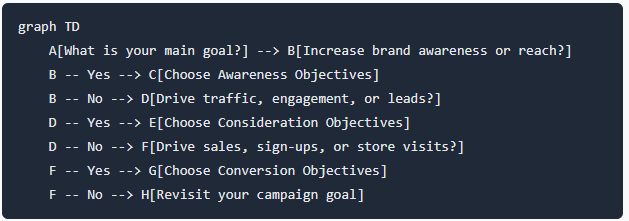
By clearly defining your campaign objective at the outset, you set your Meta Ads up for measurable success and ensure your budget is working towards the outcomes that matter most to your business.
Setting Budgets and Measuring Results
Meta Ads offers flexibility on spending. You decide whether to set a daily or lifetime budget, and even a small business can get started with just a few dollars a day. For a deeper dive into budgeting, see How Much Should I Spend on Facebook Ads in 2025.
Key budgeting strategies include:
- Daily budget: Spend a set amount per day, useful for ongoing campaigns.
- Lifetime budget: Allocate a total spend across a fixed timeframe. Helpful for short promos or sales.
Bidding works automatically for most users, although more advanced marketers can set manual bids if they want greater control.
To measure success, reporting tools inside Ads Manager display data in real time, tracking stats such as impressions, clicks, conversions, and cost per result. The platform’s pixel tracks user actions on your website, letting you connect ad spend to revenue with impressive accuracy.
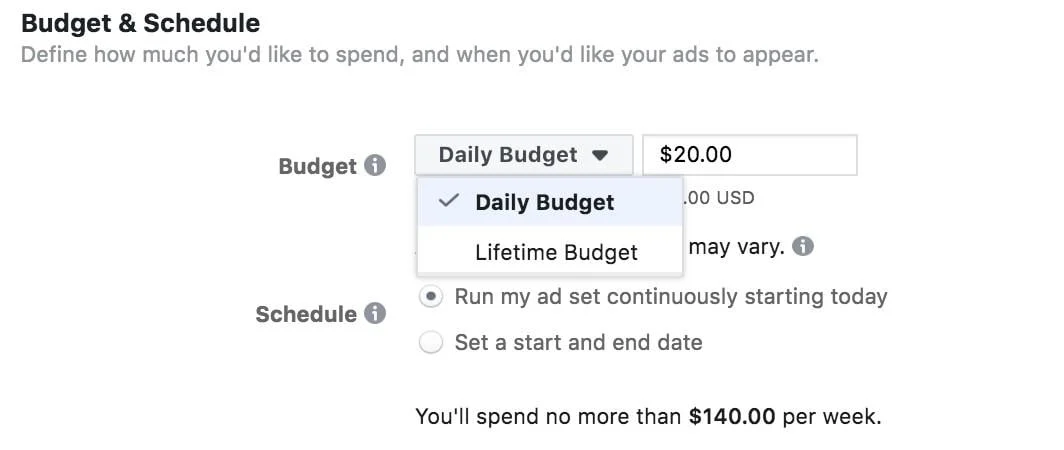
Measuring Meta Ad Performance
Measuring Meta Ad performance is essential for maximising your return on investment and ensuring your campaigns achieve their objectives. Key metrics to monitor include Click-Through Rate (CTR), Cost Per Click (CPC), Return on Ad Spend (ROAS), and conversions, all of which provide valuable insights into how your ads are resonating with your audience. These metrics can be easily accessed and analysed within Meta Ads Manager, where you can customise reports and track results in real time. To continually improve performance, implement strategies such as A/B testing different creatives, regularly refreshing your ad content, and refining your audience targeting based on data-driven insights. By consistently monitoring and optimising these elements, you can drive better results and make every advertising dollar count.
| Metric | What It Measures | Why It Matters | Where to Find It in Meta Ads Manager | Optimisation Tips |
|---|---|---|---|---|
| CTR (Click-Through Rate) | Percentage of people who click your ad after seeing it | Indicates how engaging and relevant your ad is | Performance dashboard, Columns: CTR | Test headlines, images, and calls-to-action |
| CPC (Cost Per Click) | Average cost you pay for each click on your ad | Helps manage budget and assess ad efficiency | Performance dashboard, Columns: CPC | Refine targeting, improve ad relevance |
| ROAS (Return on Ad Spend) | Revenue generated for every dollar spent on ads | Measures profitability and campaign effectiveness | Custom columns, Conversion tracking setup | Focus on high-performing audiences and creatives |
| Conversions | Number of desired actions taken (e.g., purchases, sign-ups) | Shows how well your ads drive real business results | Performance dashboard, Columns: Conversions | Optimise landing pages, use retargeting |
This table summarises the most important Meta Ads performance metrics, their significance, where to locate them in Meta Ads Manager, and actionable tips for ongoing optimisation.
Why Marketers and Businesses Use Meta Ads
Several advantages underpin the popularity of Meta Ads — it’s not just reach, but relevance. Here’s what draws brands and agencies in:
- Scalability: Suitable for solo entrepreneurs to global retailers.
- Visual storytelling: Image-rich, video-driven; ideal for brand building.
- Budget accessibility: Start small, scale fast.
- Measurement: Everything is trackable.
- Adaptability: Switch ad creative, targeting, or spend in minutes.
Whether you’re growing a local brand or reaching customers halfway around the globe, Meta Ads creates unique chances to connect and compel.
Creative Best Practices
Successful ads combine strategy, creativity, and a sharp awareness of audience preferences. Here are a few principles often seen in effective Meta Ads:
- Keep copy concise and impactful. Your message should be clear within two seconds.
- Use high-quality images or video. Blurry or slow-loading visuals stop engagement dead.
- Feature a call to action. Tell people exactly what you want them to do: “Shop now,” “Sign up,” or “Learn more.”
- Design for mobile. Over 95% of Meta’s users access via mobile devices.
- Test and iterate. Run variations (A/B testing) to see what resonates best.
Smart creative adapts to its audience, remaining authentic and fitting naturally into users’ feeds.
Common Mistakes to Avoid
Getting started is easy, but results can suffer if some pitfalls go unchecked. Watch out for:
- Poor targeting: Reaching too broad or irrelevant audiences increases costs without results.
- Ignoring data: Success comes from regular review and adjustment — guesswork rarely pays off.
- Forgetting mobile: If your visuals or landing pages aren’t optimised for smartphones, conversions will drop.
- Overcomplicated creatives: Simplicity outperforms clutter almost every time.
Being proactive about these factors keeps campaigns efficient and budgets working harder.
The Role of Privacy and Data
People want more control over their data, so Meta has introduced updates to privacy tools over the past few years. From clearer ad preferences to changes in tracking (such as Apple’s iOS privacy updates), advertisers need to be transparent and compliant.
For businesses, understanding these shifts is essential. The days of simply uploading an email list and tracking every action are changing, but with careful setup and adherence to evolving rules, Meta Ads still delivers impressive targeting and reporting capabilities.

Getting Started
Starting strong means setting clear goals. Are you hoping to boost online sales, generate leads, or promote an event? Use your objective to guide every step, from creative design to targeting and budget.
You don’t need to be a multinational or have a team of creative professionals. With time, experimentation, and attention to data, any business can find pathways to success on Meta Ads.
Experiment, analyse, and stay agile. Trends shift quickly online, but the core principles of communicating with authenticity, relevance, and clarity never go out of style.
From startups to established global brands, those willing to learn and adapt will keep winning attention, clicks, and loyalty in a digital-first world.
What’s Next for Meta Ads? Emerging Trends and the Future
As the digital landscape evolves, Meta Ads continues to innovate, offering marketers new ways to connect with audiences and drive results. Here’s a look at the trends shaping the future of Meta advertising:
AI and Automation Take Centre Stage
Artificial intelligence is rapidly transforming how campaigns are created, managed, and optimised. Meta’s AI-driven tools now automate audience targeting, creative combinations, and budget allocation, helping advertisers achieve better results with less manual effort. Expect even more advanced automation—such as predictive analytics and real-time creative adjustments—making campaigns smarter and more efficient.
New Ad Formats: AR, VR, and Threads Integration
Meta is pushing the boundaries of engagement with immersive ad formats. Augmented reality (AR) ads let users virtually try on products or interact with branded experiences directly in their feeds. Virtual reality (VR) placements are emerging within Meta’s expanding metaverse platforms, offering entirely new ways to tell your brand story. Additionally, integration with Threads, Meta’s text-based social platform, opens fresh opportunities for conversational and community-driven advertising.
Privacy and Data Transparency
With increasing global focus on privacy, Meta is adapting its ad ecosystem to prioritise user control and data transparency. Expect ongoing changes to tracking, reporting, and targeting as privacy regulations evolve. Advertisers will need to stay agile, embracing privacy-first strategies and leveraging tools like Conversions API to maintain accurate measurement while respecting user preferences.
The Rise of Automation in Creative
AI-powered creative tools are making it easier to generate, test, and optimise ad content. From automated video editing to dynamic creative testing, these innovations empower brands to deliver more relevant, high-performing ads at scale—without the need for large design teams.
Preparing for What’s Next
To stay ahead, marketers should:
- Experiment with new ad formats, especially AR and interactive experiences.
- Embrace automation for both targeting and creative.
- Monitor privacy updates and adapt strategies to maintain compliance.
- Invest in learning and testing emerging features as Meta rolls them out.
The future of Meta Ads is dynamic, data-driven, and increasingly immersive. Brands that adapt quickly and leverage these innovations will be best positioned to capture attention and drive growth in the years ahead.

